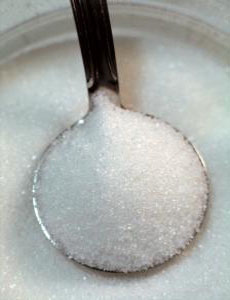All sugar products in the market place differ only in crystal size or molasses content. Molasses adds both color and flavor. The darker the brown sugar, the more molasses it has.
Sugar Classification:
Granulated or White Sugar, as it is known to consumers, is the sugar found in every home's sugar bowl, and most commonly used in home food preparation.
Coarse Sugar, as its name implies, has a crystal size that is larger than that of "regular" sugar. Coarse sugar is recovered when molasses-rich, sugar syrups high in sucrose are allowed to crystallize. The large crystal size of coarse sugar makes it highly resistant to color change or inversion (natural breakdown to fructose and glucose) at cooking and baking temperatures.
The crystal size of Bakers Special Sugar is finer than that of white sugar. As its name suggests, it was developed specially for the baking industry. Bakers Special is used for sugaring doughnuts and cookies, as well as in some commercial cake recipes to create a fine crumb texture.
Confectioners or Powdered Sugar is granulated sugar ground to a smooth powder and then sifted. It contains about 3% cornstarch to prevent caking.
Brown Sugar (light and dark) retains some of the surface molasses syrup, which imparts a characteristic pleasurable flavor. Dark brown sugar has a deep color and stronger molasses flavor than light brown sugar. Lighter types are generally used in baking and making butterscotch, condiments and glazes. The rich, full flavor of dark brown sugar makes it good for gingerbread, mincemeat, baked beans, and other full flavored foods. Brown sugar tends to clump because it contains more moisture than white sugar.
Raw Sugar is a light brown sugar with large golden crystals, which are slightly sticky from the adhering molasses. This type of sugar differs according to crystal size and molasses content.

Storing Sugar
Temperature: 70 degrees F. (room temperature).
Oxygen: Oxygen absorbers are not required or recommended for long term storage.
Packaging: Storage containers should be opaque, airtight, and moisture/odor-proof. Typical retail packaging is not suitable for long term storage. Polyethylene bags, Mylar-type bags, food-grade plastic buckets, glass canning jars, and #10 cans are all suitable for dry sugar storage.
Storage: Store in a cool, dry location (not the refrigerator). Moisture makes granulated sugar hard and lumpy, which creates problems in usage and there is no easy method to restore afterward. Store in an odor-free area, as sugar can absorb strong odors – even through plastic packaging.
Shelf Life: Indefinite – although best if used within 2 years for quality concerns (lumpiness or hardening). Brown sugars have natural moisture and do not store as well for long term storage. Color and flavor may change over time, but is still safe to consume.
Cooking with Sugar
If sugar is lumpy or hard, try breaking off pieces and putting through a food processor to break up.
Click here for 10 tips to help soften hardened brown sugar.
Sources:
- "The Wooden Spoon". A cooking school dedicated to providing information, instruction and enthusiasm to bring the family back to the table. The Guest House. 241 W. Main Street American Fork, Utah.
- "Tipnut".com. 10 ways to soften hard brown sugar. Click here for the link.






No comments:
Post a Comment